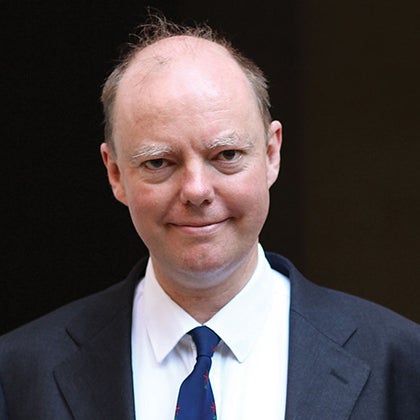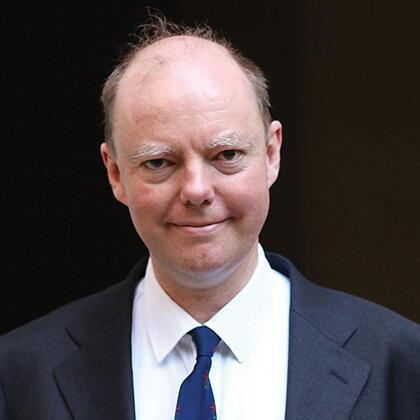Keeping the Heart Young in an Old Body
Share
- Details
- Transcript
- Audio
- Downloads
- Extra Reading
The heart was the organ that, until recently, aged fastest in wealthier societies, with death and disability from heart disease common in otherwise healthy older people. Deaths from heart disease have dropped rapidly over the last three decades, and disability from cardiac failure is substantially reduced in many countries. A combination of lifestyle changes such as reduced smoking, public health, medical and surgical interventions mean that it is now possible to keep the heart relatively young in an aging body.
This lecture will consider how keeping the heart relatively young in the elderly has been achieved in incremental steps, and the implications for other health problems.
Download Transcript
11 November 2015
Keeping the Heart Young in an Old Body
Professor Christopher Whitty
In Thomas Gresham's day, the medical importance of the heart had not been realised. It was not until around 30 years after his death that Harvey's work on circulation "De Motu Cordis" was published. At that point in history, heart disease was a much smaller part of medical practice than it is now. The gradual reduction of other causes of death and in particular infections, linked to changes in work habits and lifestyle meant that heart disease gradually increased to become the leading cause of mortality (deaths), and also morbidity (illness), in the UK and other developed countries. This reached its peak in the 1950's and 1960's. Since that time there has been a gradual but substantial reduction in heart disease, and deaths from heart disease, in both men and women
(Figure 1)
Figure 1. Age-standardised mortality rates England and Wales- circulatory, cancer, infection. (ONS 2014).
It used to be the case that a very large number of people had hearts which were for practical purposes considerably older than the rest of their body. An otherwise healthy person could have significant heart disease or indeed a fatal heart attack in their mid-60s or even earlier. Looking at the overall age of mortality over the last 30 years, this has steadily increased and a large amount of this difference is due to heart disease falling. 2012 marked the first year when cancer overtook cardiovascular disease as the leading cause of mortality in the UK. This reduction in heart disease has occurred in all ages including in the elderly (Figure 2). Very many people who are in their late 70's, 80's and 90's now have hearts which act as no brake on the rest of their body in a way that would not have been the case 30 years ago.
Figure 2. Reductions in death rates from heart disease in the elderly and the younger population (US data)
The combined effect of multiple different interventions therefore now means that many people have a relatively young heart in an old body, where they might previously have had a much older heart relative to the rest of their body where heart disease was the major or only limitation on their quality and length of life. It is not just deaths from heart disease that have gone down but also the debilitating effects of heart failure and angina on quality of life. This improvement in heart disease is one of the great successes in making lives longer but also healthier of the last half century, and whilst there is still some way to go it is likely this improvement will continue. This lecture explores how this occurred, the multiple sciences which came together to prevent for very many people the heart aging before they do, and some of the areas further improvements are likely.
The heart is in essence a relatively straightforward organ and the things which can go wrong with it are not conceptually complicated. It can go too slowly. It can go too fast. The valves of the pump can become inefficient either getting narrow (stenosis) or leaking. The coronary arteries which provide the oxygenation to the tissue can get narrowed or blocked. The muscle can fail for other reasons. Very often hearts in older people have a certain amount of several of these. All, alone or in combination, can lead to pump failure also known as heart failure.
The heart going too slowly
The first thing that can go wrong with the heart as it ages is that it can go too slowly. This may be all the time but more commonly is intermittent causing dizzy spells, faints and falls. There are a number of reversible causes such as low thyroid gland function and indeed some drugs which doctors can give. There are also some things which can have temporary effects which may include surgery or a small heart attack. In these cases the heart will recover its normal rhythm once the event is over or the complication is corrected. For the majority however these irregular rhythms are caused by small but irreversible damage to the heart, and once they have started are likely to continue and can be very debilitating.
The real advances in this area of slow heartbeat (bradycardia) have come from the improvements in diagnosis, particularly the introduction of ECG heart-tracing recorders (Holter recorders) but above all in the development of pacemakers. Pacemakers are a way of stimulating the heart to beat when it starts to miss beats for long periods of time. The pacemaker therefore has to sense when there is a pause in beating or the heart is going too slowly, and then it takes over. Early pacemakers from the 1950's and 60's were large, prone to get infected, and relatively simple in their actions. Pacemakers, due to engineering improvements in medical physics, have become steadily more reliable, more sophisticated and more effective. Modern pacemakers can be put into both the top and the bottom half of the heart (so called dual-chamber pacemakers). They can sense how fast the heart is beating and respond appropriately. Due to improvements in batteries they can now last seven or more years without needing changing and can be tested and reprogrammed through the skin using magnets without further surgery. In extreme cases where people have runs of very dangerous heart rhythms they can even provide a very small electrical shock (defibrillation) to restore it to normal function. This has revolutionised the lives of very many elderly people who prior to pacemakers would not have been able to live a normal life. In the UK around 26,000 pacemakers are implanted every year and the average age is greater than 75.
The heart going too fast
The second problem which can occur in the heart as people age is that it goes too fast. This again may be all the time, or intermittent causing dizzy spells, faints and falls. As with the heart going too slowly there can be some reversible causes in particular high thyroid function. There also can be temporary effects again like surgery. Occasionally when the heart has gone into a very rapid rhythm as a new event cardiac shocks across the heart are needed to jolt it back into correct functioning.
The most common fast rhythm in the elderly is due to atrial fibrillation. The heart has four chambers – two at the top (atrium) which contract first and then two at the bottom which contract shortly afterwards. In atrial fibrillation the top of the heart chambers are no longer contracting regularly and the atrium is contracting largely randomly. This reduces the efficiency of the heart slightly but it also can drive the rest of the heart to go too fast and in a very irregular rhythm. Atrial fibrillation steadily increases as a proportion of the population with age from being very rare under 50, to less than 10% in those up to the age of 65 to over 15% from 80. Atrial fibrillation has two implications; for stroke which we will be considering in the next lecture but also because it reduces our heart efficiency. The main thing to do with the heart efficiency is slowing the heart down to a normal efficient rate and there are a variety of drugs available to do this of which the oldest is digoxin is originally derived from foxgloves.
There are however a large number of other heart rhythms where the heart goes more quickly than it should and is therefore inefficient. Over the last two decades there has been a significant advance in permanent methods of curing this by cardiac ablation. In cardiac ablation the areas of the heart which are causing the heart to go too fast are identified, or their connections are, and then using a system fed into the heart from the groin or neck this area is ablated (scarred up so that it does not do this). The method is now extremely reliable in those who are appropriate for it with a greater than 95% success rate. This is already improving the lives of many older people and there is probably scope to do more in older patients.
In many people cardiac ablation is not currently appropriate. For these, a number of drugs are available. These include beta blockers, which block the action of adrenalin, calcium channel blockers and amiodarone. These drugs work by a variety of routes, in particular by slowing down conduction from the top part of the heart through the sinoatrial node through to the main chambers of the heart. All of these drugs were very major advances but none are ideal due to side-effects, so there is certainly room for further improvement in this area over the next years.
The heart valves fail
The third issue, which increases with age, are the valves of the heart failing. As with any pump they can fail in two ways; they can get furred up and narrow (stenosis) or they can leak or be floppy (regurgitation). Historically, a very large amount of the valvular heart disease in Europe, including the UK, was due to rheumatic fever secondary to infections particularly of the throat with streptococcal bacteria. This, called rheumatic fever, has substantially decreased over the last 40 years and is now a very small proportion of valvular heart disease. The majority is now due to effects of aging for which many of the risk factors are similar to coronary heart disease. Ultrasound techniques with Doppler have allowed this to be diagnosed much more reliably than it was when we relied on stethoscopes alone, and surgery with artificial (metal) or pig heart valves have significantly changed the outlook for people with valvular heart disease. Methods, including minimally invasive methods for replacing heart valves are improving all the time. This lecture will not go into this in any great detail since the Gresham Professor of Physic is a cardiac surgeon and is covering this thoroughly.
Coronary artery disease
By far the largest burden of disease in the elderly is coronary artery disease. Coronary arteries gradually fur up with fatty deposits and eventually calcium over a lifetime leading to angina (pain on exercise), inefficient heartbeat due to lack of oxygen supply, and eventually heart attacks where the major blood vessels of the heart suddenly block off. Every decade for the last 40 years has shown gradual improvements in the prevention, cure and averting death from coronary artery disease.
The most rapid improvement came with improvement in heart attack care. A very substantial proportion of people who had heart attacks up to the late 1980s died following them. Mortality increased steadily with age but was high in all age groups. A series of studies led to a trial in heart disease was reported in 1988 of around 17,000 patients who had had a heart attack. Up to this point there had been wide disagreement as to the best management of heart attacks. Some considered bed-rest was the most appropriate. What this trial demonstrated conclusively was that just giving aspirin to someone who had just had a heart attack reduced mortality by around 20%, a clot-busting drug called streptokinase used alone also reduced it by around 20% and the mortality dropped about 40% when the two were combined. This took the overall mortality down from 13% to 8%. This demonstrated conclusively that it was possible significantly to improve outlooks for people who had had heart attacks. By a whole series of steps, mortality has continued to drop and is now less than 2% 30 days after someone has had a heart attack.
The role of pharmacology: old drugs and new for secondary and primary prevention
This further major reduction occurred in a series of important incremental steps. Five drug classes have been at the centre of this. The first is aspirin, a drug derived from traditional medicine (willow bark) and which has been in commercial production since 1890's. The second was purposefully designed, which was the beta blocker class of drugs which block adrenalin binding to receptors in the heart and this leads to the heart being slower and contracting less forcefully. The third, ACE inhibitors were originally derived from a poison from the lance head viper leading to a drug, captopril which dropped blood pressure and reduced heart failure. The fourth class was calcium channel blockers. The fifth was the cholesterol-lowering drug simvastatin. The cocktail of these drugs lead to incremental improvements in those who had had a heart attack. The long-term outlook for people who have had a heart attack is now substantially better since they continue on a combination of these drugs. They both reduce the risk of future events happening but also significantly reduce the risk of cardiac failure. This means that people with a heart attack have a much better quality of life than they did two decades ago, as well as a much lower chance of dying.
This secondary prevention, which means prevention of conditions in people who have been found to have disease already, has been complemented by primary prevention. Primary prevention aims to identify people who do not have disease yet, but are at high risk of acquiring it. For cardio-vascular disease major modifiable factors have been blood pressure, and high cholesterol. A wide number of drugs are available to lower blood pressure and it has been demonstrated now very clearly that reducing blood pressure to low levels has substantial benefits in terms of reducing future risk of heart disease and in particular heart attacks and ischemic heart failure. The second has been lipid-lowering drugs and specifically the cholesterol-lowering drugs like simvastatin. Whilst individual people may have some problems with tolerating them (most tolerate them fine) at a population level this has significantly reduced complications of cardiac disease.
Physically opening up coronary arteries: coronary stenting and coronary artery grafting
Alongside developments in pharmacology, which reduce the speed and impact of coronary arteries narrowing with age, have been the development of methods to open up or bypass narrowed arteries. Coronary artery bypass grafting has become increasingly sophisticated but requires major surgery. The major growth area of the last 20 years has however been coronary artery stenting. This generally involves passing a mesh tube into a coronary artery narrowing from an opening in the groin or arm, and then expanding it, keeping the artery open physically. This very sophisticated method has now become very common and where there is one or only a few narrowing of major coronary arteries is very successful at reducing symptoms. The long term outlook following stenting has improved through advances such as drug-eluting stents. Stenting is now used in acute heart attacks as well as cases of angina.
Population-level public health
Alongside an approach which aims to identify high-risk individuals and treat them have been population-level public health drives. Of these the most important by some distance has been the reduction in smoking. Smoking has both short-term and long-term effects on the cardiovascular system. They damage almost every aspect of it, increasing the risk of atherosclerosis of the heart but also making the blood much more liable to clot. The improvement in cardiovascular mortality has largely tracked the decrease in smoking. Much of this effect is long-term meaning that older people now have much younger hearts due to this single measure of smoking less than they did 20 years ago. There are also immediate effects of stopping smoking as can be seen from when smoke-free legislation has come in and cardiovascular mortality dropped extremely rapidly.
An additional population-level approach is reductions in salt. There is a strong correlation between how much salt (sodium) people take in and their blood pressure and if this can be reduced at a population level it will have a very marked effect on cardiovascular risk. In the UK, whilst smoking has been addressed through a combination of taxation and legislation, reductions in salt have to date relied on agreements with the more responsible parts of the food industry. Up to 75% of all salt is taken in processed food and food eaten at home such as bread. By gradually reducing this, food manufacturers have been able to reduce salt content without people noticing any step-down in the tastiness of food.
Other public health approaches are progressing more slowly. Obesity, lack of exercise, poor diet and alcohol all contribute to avoidable heart disease. Changing these depends on changing behaviour- and this is never easy.
40 years ago, the hearts of people in the UK and elsewhere in the developed world aged far faster in many cases than the rest of the their body leading to significantly increased mortality and reduced quality of life. By a series of steps this process has been slowed, and the effects of heart disease have been substantially reduced. Multiple sciences have contributed to this including epidemiology, public health, pharmacology, medical physics and engineering, stenting and surgery. The combined effect is to keep the heart much younger in an aging body.
© Professor Christopher Whitty, 2015
Part of:
This event was on Wed, 11 Nov 2015
Support Gresham
Gresham College has offered an outstanding education to the public free of charge for over 400 years. Today, Gresham plays an important role in fostering a love of learning and a greater understanding of ourselves and the world around us. Your donation will help to widen our reach and to broaden our audience, allowing more people to benefit from a high-quality education from some of the brightest minds.


 Login
Login







